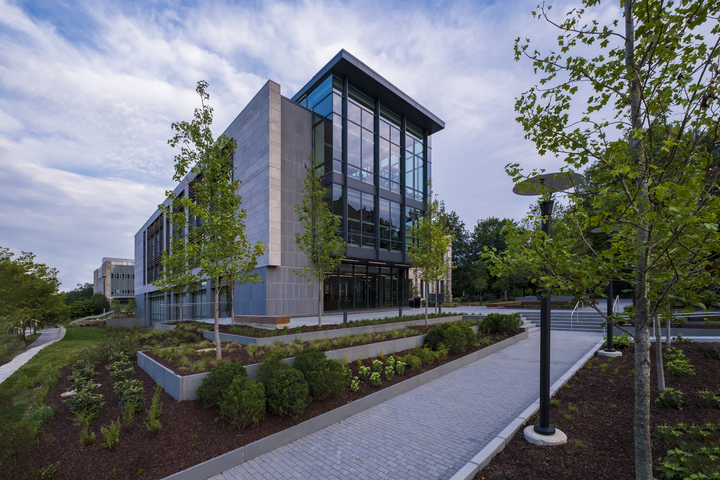Loyola University Maryland opens a new academic building for innovation and collaborative learning

Loyola University Maryland celebrates the opening of the Miguel B. Fernandez Family Center for Innovation and Collaborative Learning—the most important large-scale academic renovation on Loyola’s Evergreen campus in 10 years. The dynamic, state-of-the-art building is designed to help students innovate, learn, collaborate, and propel their careers forward.
"The opening of the Fernandez Center for Innovation and Collaboration marks a new chapter in Loyola University Maryland’s nearly 170-year history as we transform our Academic Quadrangle into a contemporary hub for the Evergreen campus," said Amanda M. Thomas, Ph.D., interim president of Loyola. "The launch of the new Fernandez Center strengthens Loyola’s active engagement in a movement to focus on innovation, entrepreneurship, and design thinking."
The University began envisioning the project four years ago. In February 2020, the University broke ground on the new 35,000-square-foot building, which is adjacent to a completely reimagined and renovated Beatty Hall. The construction project in effect doubles the size of Beatty Hall while preserving the architectural beauty of the historic building.
"The enduring Jesuit tradition of adaptability positions Loyola University Maryland to provide a ‘future-proof’ education that strengthens the bonds of the liberal arts with innovation and entrepreneurship," said Terrence Sawyer, senior vice president at Loyola. "Thanks to the generous support of donors and the State of Maryland that made the new Fernandez Center for Innovation and Collaboration possible, students graduating from Loyola will be more marketable to prospective employers and will go on to apply the world-class education they receive to create a better world."
The Fernandez Center serves as the academic heart of the campus community with features, such as:
- Active learning classrooms: Students and faculty can enjoy an interdisciplinary hub, featuring open and transparent spaces that can be reconfigured for different teaching styles, and invite members of the community to collaborate.
- Forbes Idea Lab: This space, supported by Hollis and James Forbes, ’80, chair of the Board of Trustees, is encircled by 360-degrees of whiteboards to encourage brainstorming, as well as large displays for projecting documents, presentations, and more to foster inspiration and dynamic group work.
- Rizzo Career Center: The Career Center’s footprint has expanded to a two-level space with the new Rizzo Career Center Lounge for events and four times the number of rooms for employers to interview Loyola students conveniently in the heart of campus. With the larger space, the Career Center has also doubled the size of its student career ambassador team, enabling an expanded drop-in schedule.
- Academic Loft: Located on the top floor of the Fernandez Center, this collaborative space will be a place for faculty and students to engage in interactive, innovative, and interdisciplinary learning.
- Graduate Commons: In this new-and-improved space, graduate students can enjoy maximum productivity and collaboration with whiteboards, displays to assist in working with peers and classmates, and an area to work, study, meet or relax between classes, research, or clinical work.
- Innovative faculty space: Faculty will have functional, shared workspaces designed to facilitate interdisciplinary work among colleagues. The buildings house new offices for faculty in the psychology, speech-language-hearing sciences, sociology, and education departments with space for collaboration, new conference rooms, and faculty and student research.
- Green and Grey Café: The new dining location is designed specifically for and with students in mind. The café is perfect for a lighter meal or snacks for students and staff studying or working in these new spaces in the Fernandez Center, on the Quad, or around campus. The Green and Grey Café also features a 100% living greenery wall.
- Outdoor spaces: The building is surrounded by inviting spaces for gatherings, including an outside seating area and an outdoor classroom.
The Fernandez Center is designed to be a green building on the Evergreen campus featuring:
- Efficient lighting: The Fernandez Center has 100% LED lighting, with eco-friendly solutions like occupancy and vacancy sensing, time-of-day scheduling, and daylight harvesting;
- Air purification: The rooftop air handling includes a new high-end grade unit that provides UV lights for airstream disinfection—a COVID-19 safety feature;
- Stormwater management: This system includes a 2,100-square-foot green roof garden, permeable paving, and bioretention garden, designed to help protect local waterways by capturing and filtering 100% of the rainwater that falls on the site for irrigation; and
- Water conservation: Low-flow sinks and toilets are installed throughout the building, reducing annual indoor water consumption by 40%.
Loyola anticipates that it will receive LEED gold certification for the building, which will earn it the distinction as the first LEED-certified building on campus.
The Fernandez Center was built with the help of the design team: Shepley Bullfinch provided architectural and interior design services; Mueller Associates offered mechanical, electrical, and plumbing engineering; and Hord Coplan Macht served as the landscape architect. The Center was constructed and managed by Whiting-Turner. The Fernandez Center is possible in large part thanks to the generosity of Miguel “Mike” and Constance Fernandez and the Fernandez Family Foundation.